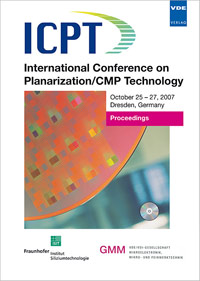In-Situ Investigation of Wafer-Slurry-Pad Interactions during CMP
Conference: ICPT 2007 - International Conference on Planarization / CMP Technology
10/25/2007 - 10/27/2007 at Dresden, Germany
Proceedings: ICPT 2007
Pages: 6Language: englishTyp: PDF
Personal VDE Members are entitled to a 10% discount on this title
Authors:
Braun, N.; Gray, C.; Mueller, A.; Vlahakis, J.; Gauthier, D.; Manno, V. P.; Rogers, C.; White, R. (Tufts University, Medford, MA, USA)
Anjur, S. (Cabot Microelectronics, Aurora, IL, USA)
Moinpour, M. (Intel Corporation, 2880 Northwestern Parkway, Santa Clara, CA, 95052, USA)
Abstract:
The objective of this project is to acquire in-situ data during chemical mechanical planarization (CMP) including slurry film thickness and flow, wafer-pad contact, wafer-scale friction, and small-scale shear force measurements. The unifying project goal is to utilize a consistent set of experimental data to develop better physical understanding of material removal rate (MRR) and polish quality during CMP. All measurements were taken on a modified Struers RotoPol-31 table top polisher in which the wafer carrier has been replaced by a computer-controlled shaft. The polisher sits atop a vibration-isolated, 3-axis, 6DOF force table to monitor wafer-scale forces and moments between the wafer and the platen. Dual Emission Laser Induced Fluorescence (DELIF) is used to characterize the slurry layer between the polishing pad and the wafer during polish. This method can be used to acquire optical data because we have replaced the standard opaque wafer with an optical BK-7 glass disk. At the same time, we are developing micro-machined, MEMS-based sensors to measure small-scale asperities and fluid shear forces and correlate these forces to macro-scale force and MRR data.


